|
|
|
Sort Order |
|
|
|
Items / Page
|
|
|
|
|
|
|
| Srl | Item |
| 1 |
ID:
131029
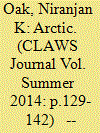

|
|
|
|
|
| Publication |
2014.
|
| Summary/Abstract |
Regionalism as a political project has been a signi?cant phenomenon in post-1945 international relations. The third phase of regional integration began towards the end of the 19805 within the international context created by the end of the Cold War. Academics dubbed it as "new regionalism".' Most of the regional organisations that came up in those days were based on economic cooperation among the states. It was an era of globalisation. The Arctic Council (AC) which emerged in 1996 was a unique case. The 'Arctic' has emerged as a region in international cooperation during the past 20-30 years, as manifest in the creation of the AC. The objective of the AC was sustainable development and environmental protection only, and that is why it may be termed as a unique case in that period.
|
|
|
|
|
|
|
|
|
|
|
|
|
|
|
|
| 2 |
ID:
131026
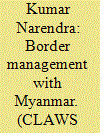

|
|
|
|
|
| Publication |
2014.
|
| Summary/Abstract |
Neighbouring states are most relevant in foreign policy' and Myanmar, indeed, has strategic, economic, cultural and religious signi?cance for India. Myanmar is not where only China and India 'meet'; it is also the intersection between South Asia and Southeast Asiaz. It is a gateway to South Asia and a land bridge to the Association for Southeast Asian Nations (ASEAN). It is an opportunity and also brings with it a certain amount of vulnerabilities as well. Myanmar has huge potential for meeting India's energy requirement and for markets for Indian consumer goods; in return, India can contribute immensely in the field of infrastructure development, communication, education, tourism industry, science and technology. India and Myanmar are historically linked to each other through religion, people-to-people contact and sharing ethnically identical populations on both sides of the borders. The porous land borders of India and Myanmar are a cause of concern for peace, stability and economic development. Inhospitable terrain and an underdeveloped border region provide an ideal platform for insurgents, non-state actors, drugs and weapons traffickers to operate and spread their network
|
|
|
|
|
|
|
|
|
|
|
|
|
|
|
|
| 3 |
ID:
131024
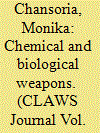

|
|
|
|
|
| Publication |
2014.
|
| Summary/Abstract |
In a March 2014 report, the United Nations human rights investigators con?rmed that chemical weapons were indeed used in Syria in 2013, which apparently came from the stockpiles of the Syrian military, whose chemical weapons stash reportedly included mustard gas. The report con?rmed that the deadly nerve agent Sarin was used in three separate incidents: the Damascus suburb ofal-Ghouta in August 2013, Khan al-Assal in March 2013 and Saraqeb near the northern town of ldlih in April 2013. While the Bashar al-Assad government and the Syrian opposition indict each other of using chemical weapons, which are strictly banned as per existing international law and convention, the incidents amount to being the deadliest chemical attacks the world has witnessed in almost a quarter of a century.
|
|
|
|
|
|
|
|
|
|
|
|
|
|
|
|
| 4 |
ID:
131031
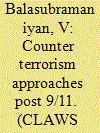

|
|
|
|
|
| Publication |
2014.
|
| Summary/Abstract |
Most studies on terrorism and political violence by experts and researchers have focussed on the causation factors of terrorism over the years. A majority of the scholarly works has mostly focussed on the historical, ideological, and etiological aspects of terrorism and insurgency. Scholars, researchers and investigators have attempted to epitomise and de?ne terrorism as a phenomenon, and have admitted to the problems in ?nding a universally acceptable de?nition. They have primarily focussed on bringing out an acceptable definition of terrorism in all its manifestations and forms, and in the process, have analysed the roots, origins and growth of terrorism. Compared to the enormous literature on the growth and incline of terrorism the world over, studies or scholarly works on the decline of terrorism or insurgency are not as vast and are limited in number.' A few experts like Martha Crenshaw and Audrey Cronin have dealt with this aspect in detail.' However, these attempts comprise only a fragment of the total terrorism literature in place.
|
|
|
|
|
|
|
|
|
|
|
|
|
|
|
|
| 5 |
ID:
131027
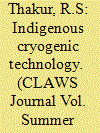

|
|
|
|
|
| Publication |
2014.
|
| Summary/Abstract |
From launching sounding rockets on the Kerala coast in the 19605, to the launch of ten satellites in one go in April 2008, Indian space scientists have indeed come a long way. In fact, this January, taking one more crucial step in space technology has further strengthened their resolve to accomplish other space-related goals. After two decades of the protracted and focussed research and developmental efforts of the Indian Space Research Organisation (ISRO) scientists, it was India's turn to celebrate the glory of its space programme on January 05, 2014, when ISRO's Geosynchronous Satellite Launch Vehicle (GSLV-D5), powered by an indigenously developed cryogenic engine, successfully launched the GSAT- 14, a communication satellite, from Sriharikota
|
|
|
|
|
|
|
|
|
|
|
|
|
|
|
|
| 6 |
ID:
131021
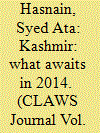

|
|
|
|
|
| Publication |
2014.
|
| Summary/Abstract |
Kashmir was some years ago perceived as an open and shut case where terrorism needed to be swamped and all would return to normal. That usually is a perception which prevails about most internal conflict situations when they are at the peak of conflict progression in terms of ?ghting and other military related activities. Solutions are seldom looked at comprehensively as militaries get self-obsessed with controlling the quantum of violence. Their goals usually remain limited to the subjugation of violence and creation of the much sought after threshold from \\-'here a political process can proceed. That can happen in internal conflicts which are stand-alone and where linkages are limited. In the case of Kashmir, it is questionable whether the con?ict is internal in nature at all because of the deep-set up for linkages which extend to our neighbourhood
|
|
|
|
|
|
|
|
|
|
|
|
|
|
|
|
| 7 |
ID:
131030
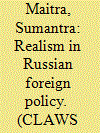

|
|
|
|
|
| Publication |
2014.
|
| Summary/Abstract |
The Crimean crisis marks a pivotal point in the rations between Russia and the West. The revolution in Ukraine, and the subsequent events that unfolded at breakneck pace, including the annexation of Crimea by Russia, throws up a lot of questions, the answers to which will have a massive impact on foreign policy and inter-state relations in the future. It also throws up some broad patterns. The crisis is a worrying return to a trend of land annexation by a great power on a pretext, a trend which was thought to be long dead Munich Conference of 2007. It brings back the debate on the concepts of "Perception and Resolve" in foreign policy. And, perhaps, most importantly, it serves as a vindication of realists over the liberals, constructivists and other paradigms of international relations, and validates the often discussed idea that state interests triumph over every other aspect.
|
|
|
|
|
|
|
|
|
|
|
|
|
|
|
|
| 8 |
ID:
131028
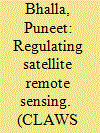

|
|
|
|
|
| Publication |
2014.
|
| Summary/Abstract |
The freedom of operations in space and of remote sensing by satellites has been globally accepted through different UN Conventions. Satellite imaging provides unrestricted access to areas transcending international borders and its commercialisation has resulted in the irrelevance of these borders even for distribution of data as commercial entities seek a larger and more diversi?ed customer base. Availability of such information commercially is enabling and in?uencing worldwide scienti?c, technological, social and economic advancements. However, its dual use potential that could provide disproportionate strategic and military advantages has raised concerns regarding the distribution. Differing interests have made regulating the sector a complex task. Nations that possess the capability want to strike a balance between their national security interests and foreign policy concerns, on the one hand, and commercial interests, on the other. At the same time, all nations remain apprehensive about the distribution of information about their area without their knowledge or consent.
|
|
|
|
|
|
|
|
|
|
|
|
|
|
|
|
| 9 |
ID:
131023
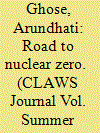

|
|
|
|
|
| Publication |
2014.
|
| Summary/Abstract |
India-Japan relations are an important in?exion point, where we have, earlier, rarely had the opportunity of exchanging views on matters of strategic importance to both our countries, particularly in the areas of
nuclear disarmament, nuclear non-proliferation and nuclear weapons in general. Both India and Japan face threats of a nuclear nature, both overt and latent, yet have been at the forefront of supporting the cause of a world free of nuclear weapons. India is a nuclear-armed state, faces two nuclear armed neighbours with whom it has, if not hostile, at the least, adversarial relations, including territorial disagreements, while Japan, which is protected by a nuclear umbrella, also faces dangers from two nuclear armed neighbours. Yet, both countries appear to remain staunch in their support of Nuclear Zer0-the complete elimination of nuclear weapons. Both countries have often sponsored resolutions in the UN calling for nuclear disarmament, but, unfortunately, almost always, separately.
|
|
|
|
|
|
|
|
|
|
|
|
|
|
|
|
| 10 |
ID:
131019


|
|
|
|
|
| Publication |
2014.
|
| Summary/Abstract |
Sam Hormusji Framji Iamshedji Manekshaw was born in the holy city of Amritsar, on Friday, 3 April 1914, to Hormusji Manekshaw and his wife Heerabai. It was while studying medicine at Grant Medical College, Bombay that I-Iormusji met Heerabai and later married her. The couple, residents of Valsad, a small coastal town in Gujarat, thereafter migrated to Amritsar, in search of better opportunities. On that pleasant April day in Amritsar when Heerabai held Sam for the first time in her life, the fifth of six children she would have, little could she have imagined that the child in her arms was destined to make history. Three months later, in July, World War I broke out, and when the war ended in November 1918, Sam still had a few months to go for his fifth birthday. He was an infant in World War I, but he was to prove his mettle as a young officer in World War II and was destined to lead his country to its greatest military victory when in command of the Indian Army in 1971.
|
|
|
|
|
|
|
|
|
|
|
|
|
|
|
|
| 11 |
ID:
131025
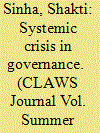

|
|
|
|
|
| Publication |
2014.
|
| Summary/Abstract |
Till a few years ago, the Indian elite had convinced itself that India was already seated at the high table of the international order, that there was something natural and given about lndia's rise. This acute sense of triumphalism was unmistakeable. India in 2007 had reason to be con?dent. It was growing fast and furious, had lifted hundreds of millions above the poverty line, and was being courted by leading economies and large investors and the India story seemed a perpetual best-seller. The 2008 trans-Atlantic monetary crisis saw the rich countries go into economic decline whilst India recovered quickly and grew faster than before. The clear conviction was that India had decoupled itself from its economic partners in Europe and North America, and was itself an engine of global economic growth. The fact that China also grew faster than before convinced many that the West was in terminal decline and the future of Asian dominance had arrived. The hubris was not long in coming. Indian policy-makers did seem to have not taken notice of the fact that the high growth of Gross Domestic Product (GDP) post-2003 had resulted Mr Shakti Sinha is former Principal Secretary (Power 8: Industry), Government of National Capital Territory of Delhi and former Chief Secretary, Andaman 8: Nicobar Administration.
|
|
|
|
|
|
|
|
|
|
|
|
|
|
|
|
| 12 |
ID:
131022
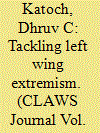

|
|
|
|
|
| Publication |
2014.
|
| Summary/Abstract |
An analysis of Left Wing Extremism (LWE) related incidents show's a welcome declining trend over the last three years. The _year 2008 witnessed 1,591 incidents of Naxal violence, which rose to over 2,200 in both 2009 and 2010. Since then, there has been a dip to 1,760, 1,415 and 1,129 incidents across the country for the years 201 1, 2012 and 2013 respectively.' The fatalities due to Naxal violence have also registered a sharp decline over the last three years (see Fig 1)? The trends indicate improved capability of the state governments and their security forces to deal with attacks by Maoists, especially on police posts. However, they do not indicate any appreciable degradation in the strength of the armed Wing of the Maoist groups, most notably the People's Liberation Guerrilla Army (PLGA) of the Communist Party of India (Mam), [CPM(M)] which does not appear to have been weakened in any appreciable manner.
|
|
|
|
|
|
|
|
|
|
|
|
|
|
|
|
|
|
|
|
|